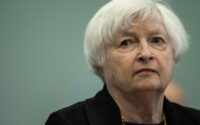Soaring food prices across the board are hitting hard consumption in developed countries
Explanation : The FAO Food Price Index (FFPI) is a measure of the monthly change in international prices of a basket of food commodities. It consists of the average of five commodity group price indices weighted by the average export shares of each of the groups over 2014-2016. See this article for further technical background on the construction of the index.
Expect things will get worse, in the short term at least. We already know how vulnerable emerging and developing countries are to food price fluctuations (32 countries in Africa are importing more or less 90 % of basic foods). This means higher political instability in the emerging world. But what is new is that developed countries are hit hard by soaring prices too. Several developed countries are experiencing strong wage increases since the reopening of the economy (even in the eurozone where wages are finally catching up). But this is not enough to cope with higher inflation. Our baseline is that the lowest income quintile in the developed world (around 15-20 % of households) will face a severe income squeeze in the coming months.
A lot of food items are price inelastic – or not responsive to price. But not all of them. We say that prices are inelastic when a price increase does not induce a drop in consumption (most of the time, because the items are considered as essential). According to the U.S. Department of Food, the price elasticity of U.S. household demand for bread and cereals is at 0.04 – when the reading is much below 1.0, it means that the item is not responsive to price. This makes sense. Bread and cereals are often basic items in the grocery list for the poorest households. There is no immediate substitute either. Studies show only a major increase in prices for basic items can lead to a drop in consumption – meaning a double-digit increase. The U.S. Department of Food takes the example of a 25 % increase in bread prices leading to a 1 % fall in consumption. However, some food items are price elastic, such as food away from home, juice, soft drinks etc. According to the U.S. Department of Food, a 10 % increase in soft drink prices should reduce consumption by 8-10 % on average. The poorest households are now facing a trade-off between eating pasta or fresh meat. This is as basic as that. A study from France’s national office of statistics (INSEE) shows that when the prices of cereals and pasta increase by 1 % on average, this induces a drop of 0.23 % of the quantity of consumed meat, for instance. Basically, households give up on what is seen as the most expensive or ‘luxury’ expenses in the grocery list.
Higher food prices will cause a major drop in consumption. In the current context of prolonged high inflation, the consumption of essential food items (inelastic prices) will likely remain stable in most developed countries. But the consumption will drop for other food items and unnecessary expenses (trips, electronics, hotels etc.). Several countries are already experiencing a significant decrease in consumption. In France, household consumption of goods fell 1.3 % in March 2022 in volume. The drop is mostly explained by a decline in food consumption (minus 2.5 %). Looking into details, this only concerns inelastic food demand (sweets and sugar, eggs, cheese etc.). This is cause for concern. In most developed countries, consumption is the main driver of economic growth. This increases the risk of stagflation or, in some cases, of recession (typically in the United Kingdom). Expect political turmoil as well. From where I am sitting (in Saxo’s Paris office), I would not be surprised that France will face massive demonstrations after the summer break with people getting down in the streets to protest against high cost of living and high food prices (remember that the 2018 Yellow Vest Movement was initially caused by an increase in fuel prices). What is certain is that we will not experience another Roaring Twenties, contrary to what several colleagues believed when the developed economies reopened in Spring last year. The economic outlook is gloomier.
[ad_2]
Source link


